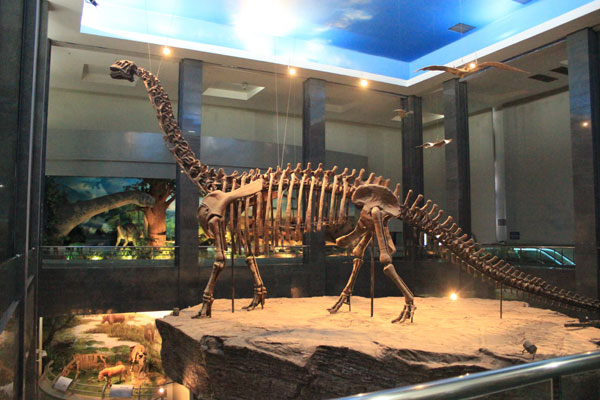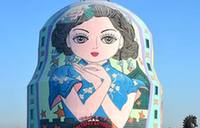A trip through time
|
The 26-meter-high skeleton of Nurosaurus, displayed in the Inner Mongolia Museum, is the biggest dinosaur fossil from the Cretaceous period ever found in Asia. [Photo by Wang Kaihao / China Daily] |
With the temperature dipping below freezing, Wang Kaihao finds refuge in the Inner Mongolia Museum in Hohhot, and embarks on a fascinating journey into the region's rich history.
If the Inner Mongolia autonomous region's capital Hoh-hotis the gate way for people from all over the world to explore the region's grasslands and ethnic cultures, the Inner Mongolia Museum in the east of the city is the best guide book for first-time visitors preparing to travel deeper into the region.
During the long winter in Hoh-hot, outdoor tourist attractions lose some of their charm as the whole city is frozen. The museum, however, still offers an excellent travel experience.
Covering an area of 15,000 square meters, the museum has more than 100,000 exhibitions and boasts the country's most complete collection of artifacts of the history and culture of the Mongolian ethnic group. This is my second visit in winter. Compared with visiting in summer, when the place is packed with people, a quiet museum is much more suitable to study the historical legends and take in the panorama of the region's natural wonders.
The museum is free to visit. What makes this trip even better in this low season is that I have a private tour guide for free.
Unusually, the guide starts the tour from the second floor, where the ancient cultures of the vast grasslands are traced back to prehistoric times, giving a brief but informative introduction to numerous nomadic ethnic groups who once lived in this region, including Xiongnu (possible predecessors of Huns),Xianbei and Mongols, as well as their interweaving histories and connections.
A replica of the C-shaped jade dragon, which was first discovered in Inner Mongolia's eastern city of Chifeng in 1971,is an excellent example of the region's rich prehistorical civilizations. The jade dragon, made during the time of Hongshan culture (estimated 4,700 to 2,900 BC) is the oldest dragon image ever found in China.
I am most drawn to the key exhibits of the museum: the only crown of a Xiongnu chanyu (nomadic supreme leader) ever discovered in China. This 1,394-gram golden crown, which was made during the Warring States Period (475-221 BC)and unearthed in Ordos, a city in the west of Inner Mongolia, in 1970,is crested with an eagle overlooking a fight between wolves and sheep.

















